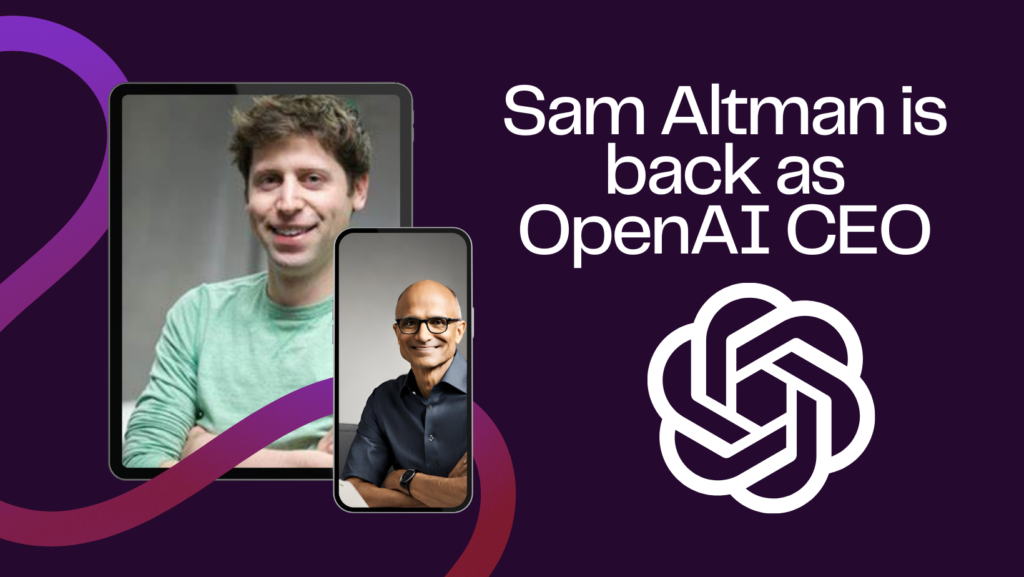In a dramatic turn of events, Sam Altman, the recently ousted CEO of OpenAI, is set to make a surprising return, overcoming a tumultuous weekend of boardroom chaos. The company released a statement late Tuesday announcing an “agreement in principle” for Altman’s reinstatement, alongside former president Greg Brockman. This unexpected development follows days of uncertainty and employee unrest, with Altman’s return signaling a potential shift in the governance of OpenAI.

Additional Insight from Sam Altman and OpenAI:
In a tweet addressing the recent developments, Sam Altman expressed his deep commitment to OpenAI, stating, “I love OpenAI, and everything I’ve done over the past few days has been in service of keeping this team and its mission together.” Altman emphasized that joining Microsoft on Sunday evening was a strategic decision made in the best interest of both himself and the OpenAI team. He highlighted the clarity that emerged with the new board and Microsoft CEO Satya Nadella’s support, expressing eagerness to return to OpenAI and build on the strong partnership with Microsoft.
OpenAI echoed these sentiments in a tweet, confirming the “agreement in principle” for Sam Altman’s return as CEO. The new initial board, composed of Bret Taylor (Chair), Larry Summers, and Adam D’Angelo, reflects a collaborative effort to redefine the governance structure of the organization. While working diligently to finalize the details, OpenAI expressed gratitude for the patience shown by its community throughout this period of uncertainty.
Emmet Shear, the interim CEO of OpenAI, shared his sentiments on Twitter following the announcement of Sam Altman’s return. In his tweet, Shear expressed deep satisfaction with the outcome, stating, “I am deeply pleased by this result, after ~72 very intense hours of work.” Acknowledging the challenges faced during the tumultuous period, Shear admitted uncertainty about the right course of action upon assuming leadership at OpenAI. However, he affirmed that the chosen pathway, which maximized safety and considered the interests of all stakeholders involved, brought about a positive resolution. Shear concluded by expressing gratitude for being a part of the collaborative solution, highlighting his commitment to steering OpenAI through the evolving landscape of AI innovation.
I am deeply pleased by this result, after ~72 very intense hours of work. Coming into OpenAI, I wasn’t sure what the right path would be. This was the pathway that maximized safety alongside doing right by all stakeholders involved. I’m glad to have been a part of the solution. https://t.co/AGoDBbwhkq
— Emmett Shear (@eshear) November 22, 2023
These statements provide a glimpse into the collaborative spirit and determination to preserve OpenAI’s mission, underscoring the significance of a unified team and strong partnerships in navigating the complexities of the tech industry. As Altman prepares to resume his role, and the new board takes shape, the focus remains on fostering innovation and advancing the ambitious goals that define OpenAI’s vision for the future.
The Unraveling Drama at OpenAI
Altman’s comeback is nothing short of astonishing, considering the firm stance taken by OpenAI‘s nonprofit board in removing him just days ago. The board went through two CEOs in a span of three days to avoid reinstating Altman, leading to a wave of discontent among OpenAI employees. Threats of defection to Microsoft, along with Altman and co-founder Greg Brockman, loomed large unless the board yielded to the employees’ demand for resignation.
Throughout the saga, the board members opposing Altman remained tight-lipped about the reasons behind his dismissal, even in the face of potential lawsuits from investors. Notably, Ilya Sutskever, a key board member, switched sides and aligned with Altman, leaving the remaining three members vulnerable. Interim CEO Emmett Shear, appointed in the midst of the turmoil, reportedly pushed for evidence supporting Altman’s firing, threatening to resign if the board couldn’t provide documentation. This move prompted the board to reopen negotiations, ultimately leading to Altman’s potential reinstatement.
The Path to Reconciliation:
The statement released by OpenAI indicates that Altman’s return comes with a plan to form a new board, comprising Bret Taylor, Larry Summers, and Adam D’Angelo. D’Angelo, a holdover from the previous board, will offer continuity and representation for the initial small board tasked with vetting and appointing a larger board of up to nine members. Microsoft is expected to have a seat on the expanded board, reflecting the significant financial backing it has provided to OpenAI.
Altman and Microsoft CEO Satya Nadella have both confirmed the deal on social media, signaling that the return is imminent pending final paperwork. The use of the term “in principle” in the announcement leaves some details open-ended, and OpenAI has chosen not to provide additional comments at this time.
Conclusion:
Sam Altman’s unexpected return as the CEO of OpenAI marks a potential turning point in the recent turmoil that engulfed the organization. The swift reversal comes after a weekend of intense negotiations, employee revolt, and a lack of transparency from the board regarding Altman’s dismissal. As the dust settles, the focus now shifts to the formation of a new board, and the role Microsoft will play in shaping OpenAI’s future. The unfolding events serve as a reminder of the dynamic nature of leadership transitions in the tech industry, emphasizing the importance of clear communication and collaborative decision-making in navigating the complexities of cutting-edge technology companies.
